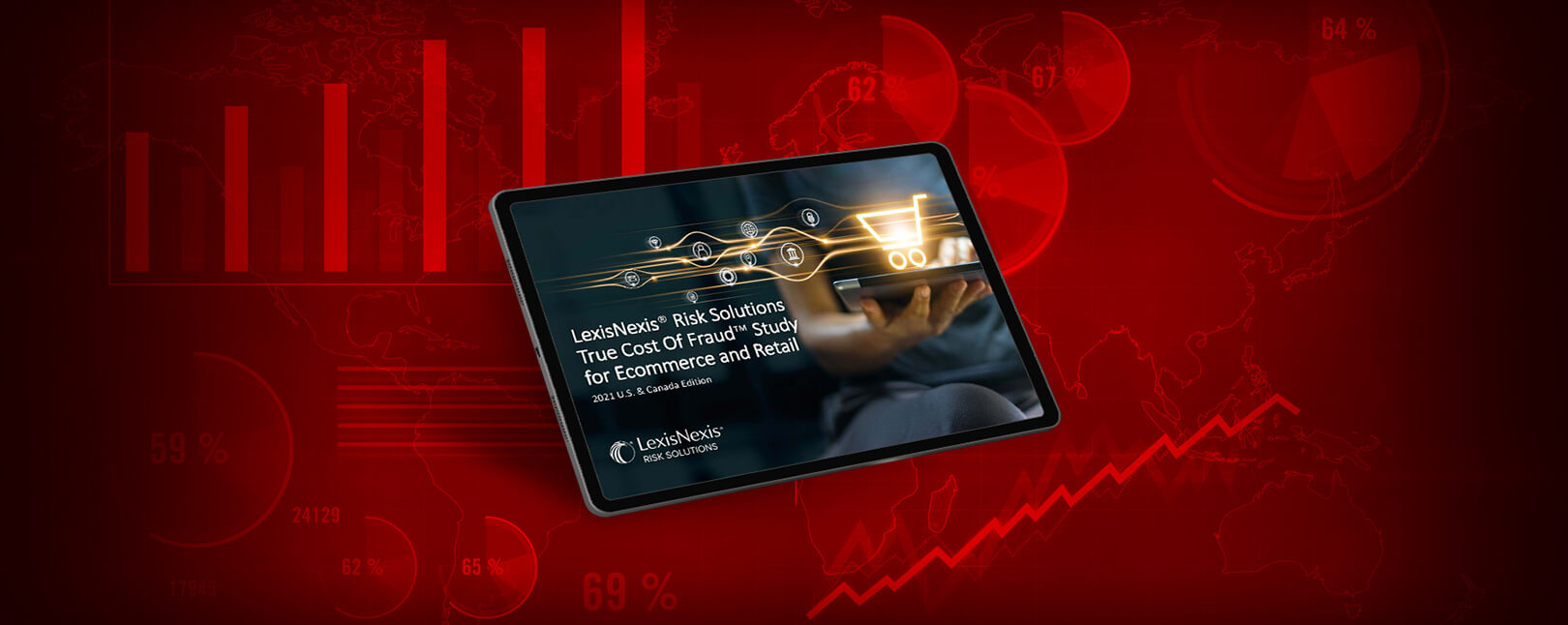Top 10 Fraud Prevention Takeaways from the 2021 LexisNexis® True Cost of Fraud Study
It’s here: risk assessment firm LexisNexis® Risk Solutions released their highly-anticipated 2021 True Cost of Fraud℠ Study back in August.
This annual report is a key source of insight into current fraud trends and developments. This year’s study draws on the firsthand experiences of more than 1,000 executives in the fraud management space.
The report once again shows fraud challenges and cost pressures continue to plague retailers across the US. As expected, the Covid-19 pandemic seems to have had a substantial impact on the already-existing upward trend in fraud risk for the retail and eCommerce sectors. The study noted a sharp year-over-year rise in card-not-present (CNP) fraud, and mCommerce fraud in particular
The annual study is considered one of the best indicators of where the payments and eCommerce industries stand regarding fraud and chargebacks. While the report offers countless valuable insights, we’ve looked at several of the key takeaways and offer additional analysis of our own.
#1. Merchants Are Experiencing More Fraud Than Ever Before
Respondents in the US eCommerce space reported a 34.4% increase in the cost of fraud in 2021. Even more startling, they noted a 140% increase in fraud attacks since 2020.
This could be partially attributed to Covid-19. As we’ve pointed out before, global shutdowns in sectors like retail and food and beverage, coupled with stay-at-home orders and quarantine guidelines, led to a surge in eCommerce activity beginning in March 2020. Of course, fraudsters are opportunistic; they know that fraud detection resources are stretched thin at the present. In response, many took advantage of the sudden shift in consumer shopping patterns to commit more CNP fraud.
#2. Fraudsters Are Seeing More Success
The report finds that the average US retailer sees 1,740 fraud attempts each month. Of these, just slightly more than 50% are successful.
2021 marks the first year in which successful fraud attempts have overtaken those prevented. Overall, the number of successful fraud attacks rose 52% since 2020. While this is a sobering figure, it’s not too surprising.
As we noted above, the last year saw sudden changes in consumer behavior, coupled with limited merchant resources, plus internal staffing and logistics challenges resulting from the pandemic. In this situation, fraudsters were more than happy to capitalize on the vulnerability of both merchants and consumers.
#3. The Cost of Each Fraud Attack is on the Rise
So, we know that fraudsters are committing more fraud. We also know that they’re getting away with it more often. But, as if that weren’t bad enough, we must also consider that the direct cost of each fraud attack is just a small portion of the actual impact on your bottom line.
The LexisNexis Fraud Multiplier™ projects that, for every dollar lost in a fraud attack in 2021, US retail and eCommerce merchants will ultimately lose $3.60. This is compared to $3.13 prior to the pandemic, a 15% increase.
We can attribute these additional losses to a variety of sources. Chargeback fees and administration, overhead costs, more expensive processing, and threats to business sustainability all take a toll.
#4. Replacing Merchandise Is a Major Drain on Merchants’ Resources
Lost merchandise is the biggest single source of loss resulting from criminal activity. According to the study, nearly half (47%) of fraud costs borne by eCommerce merchants in the US are related to replacing and/or redistributing lost goods. This is a stark figure if we look at it in the context of another loss source like product returns.
As we’ve noted on the blog before, return fraud—the practice of requesting a return without a valid reason to do so—accounts for more than $25 billion in unnecessary returns processed in the US every year. That’s bad for retailers, as each return involves overhead costs like shipping fees, interchange fees, and restocking costs. You can recoup these costs if the merchandise arrives in resalable condition, though. That’s not the case with merchandise lost to fraud.
#5. Verifying Buyers & Balancing Friction Are Top Challenges
Identity verification (39%) is the top eCommerce challenge for US retailers, followed by balancing fraud prevention with friction (29%) and email or device verification (27%).
Identifying buyers is inherently riskier in a card-not-present environment. You never come face-to-face with your customer. At the same time, it’s easier for a customer to simply click away and abandon a purchase if there’s too much friction. So, how do you accurately identify buyers without causing too much friction?
It’s important to distinguish between “positive” and “negative” sources of transaction friction. Taking a dynamic approach to friction can allow you to screen out abuse with little—if any—impact on the customer experience.
Put Fraudsters in Their Place.
Move from defense to offense in the fight against chargebacks and fraud. Learn how today.

#6. Fraudsters Are Targeting Mobile Channels
The portion of fraud taking place in mobile channels jumped in 2021, more than tripling from 8% of US retail fraud in 2020 to 27% in 2021. Looking at US eCommerce specifically, 39% of fraud costs are incurred in mobile channels. Also, the distribution of fraud by mobile payment method has shifted from browsers (26% of mobile fraud in 2021) to mobile apps (47%) and text-to-pay/bill-to-mobile (28%).
mCommerce is no longer strange terrain for most merchants. However, even though mobile channels offer unique advantages like 2-factor authentication, this clearly isn’t a perfect solution.
It’s likely that there is some statistical noise influencing this figure due to the widespread and rapid adoption of mobile options like click-and-collect during the pandemic. It will be interesting to see if mCommerce fraud continues to spread at this accelerated pace in a post-pandemic environment.
#7. Merchants Are Deploying a Variety of Tools to Fight Fraud
According to the report, the average US retailer deploys eight fraud prevention solutions to try and screen out abuse.
Top 10 Fraud Prevention Tools, Ranked by Usage Among US Retailers:
- Geolocation: 57%
- OTP/2-Factor: 53%
- Real-Time Fraud Detection: 52%
- Authenticate Using Payment Instrument: 51%
- Behavioral Biometrics: 50%
- Authenticate Using Biometrics: 50%
- Automated Transaction Scoring: 49%
- Positive & Negative Lists: 48%
- Email Risk & Verification: 48%
- Phone Number Risk & Verification: 47%
#8. Key Metrics: Declines, Manual Reviews & Chargebacks
It should be no surprise when we say that the metrics you deploy to gauge your performance are extremely important. Tracking the right metrics allows you to ask important questions about your business. For instance, are you stopping preventable losses? Are you maximizing your revenue? Are you accidentally deterring good buyers?
Top 5 Merchant Fraud Prevention Performance Metrics Among US Merchants:
- Automatic Decline Ratio: 47%
- Manual Review Rates: 44%
- Chargeback Rates: 41%
- Order Approval Rates: 40%
- Average Time for Order Reviews: 39%
#9. More Merchants Integrating Cybersecurity & Fraud Prevention
According to the True Cost of Fraud study, just over one-half of US and Canadian merchants are using cybersecurity alerts to support fraud prevention. The reason why may not be clear at first glance; after all, securing data has no immediate impact on fraudsters who submit unauthorized transactions. It makes sense, though, when we consider that a typical data breach can result in:
- Reputational Damage: Your customers trust you with their data. A data breach can be viewed as a violation of that trust, thereby permanently affecting your relationship with buyers.
- Increased Fraud Risk: Every successful hack means there is more data floating around in the ether. This inherently increases the baseline threat of a fraudulent transaction.
- More Chargebacks: Customers will be hyper-vigilant after a breach. If they see a transaction they can’t immediately recognize, they’ll be more likely to assume it’s fraudulent and dispute it.
For these and other reasons, there has been a significant increase in the percentage of US merchants that integrate their cybersecurity operations with fraud prevention. In fact, 51% of respondents say they are "fully" integrated.
#10. Merchants See Better Results Through Integration
The data is clear: merchants who invest in best-practice, multilayered solutions experience fewer successful fraud attempts. Respondents who integrate multilayered fraud management, cybersecurity, and digital-experience operations see a 71% lower volume of successful fraud attacks. In addition, they also enjoy a 12% lower cost of fraud.
This hammers home the point we made earlier about the importance of multilayer fraud management. To maximize effectiveness, you should deploy several complimentary fraud detection tools backed by intelligent fraud scoring, plus end-to-end chargeback management, risk assessment, and more.
Have Additional Questions?
This is just a small sample of the insights contained in the full report. We strongly encourage you to download the LexisNexis 2021 True Cost of Fraud℠ study to gain a full picture of the state of fraud in 2021 and beyond.
Do you have other questions about building out your strategy to prevent fraud, eliminate chargebacks, and recover more revenue? Click below and learn how much you stand to save.













